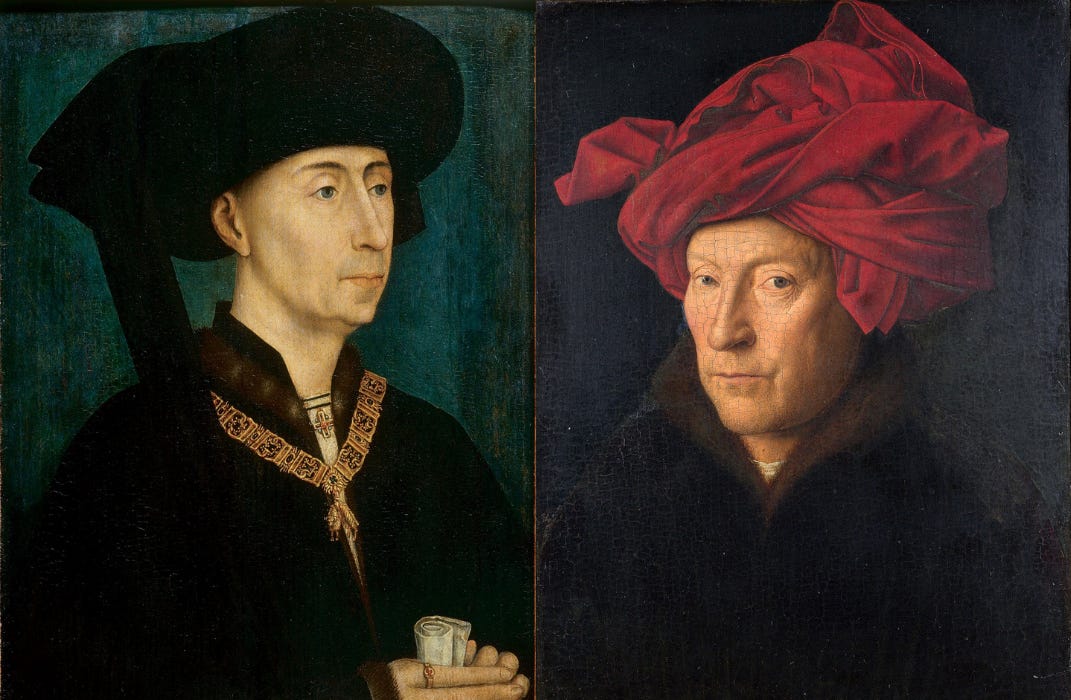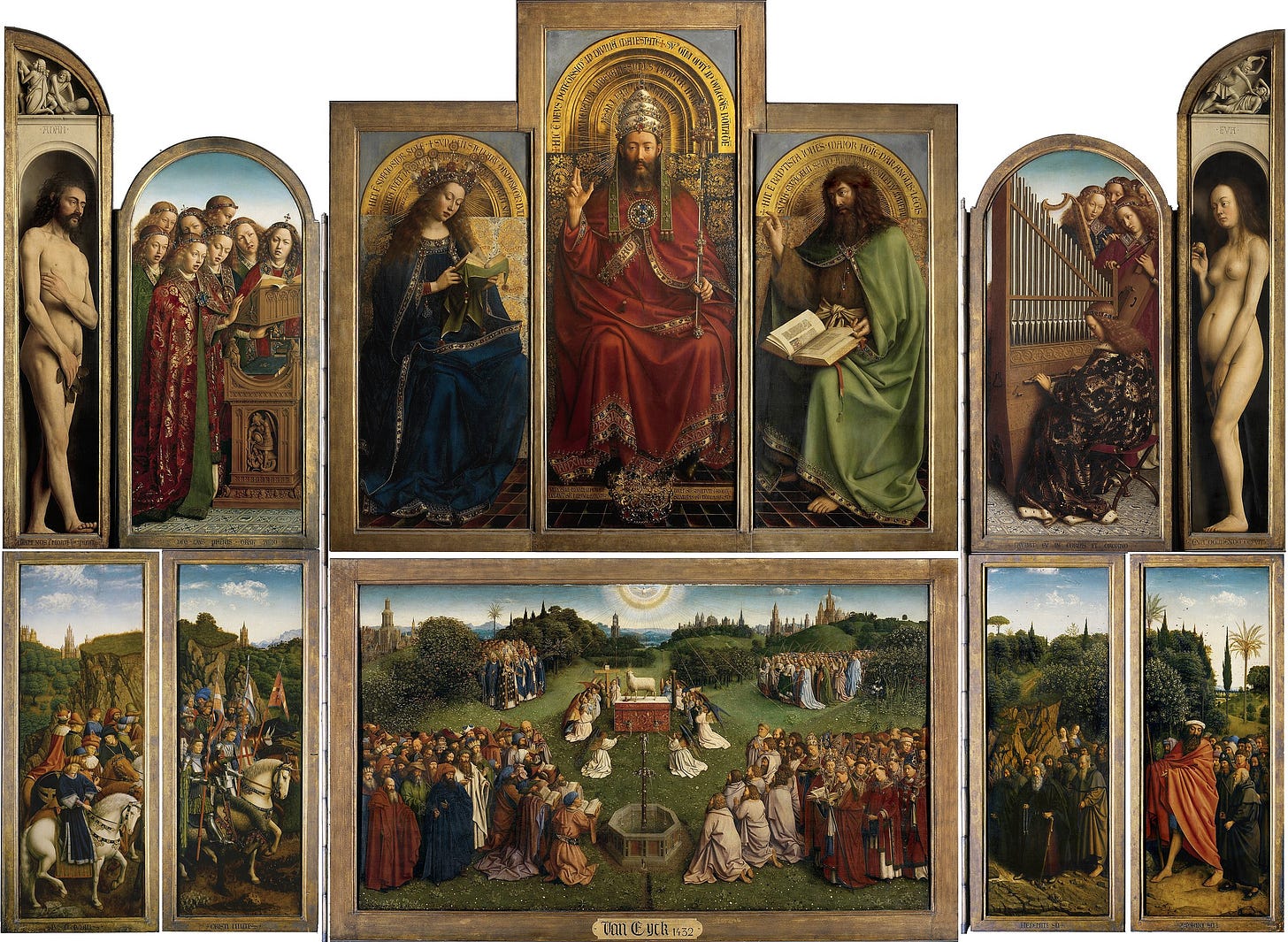Van Eyck The Mission That Changed Europe
Everyone knows Jan van Eyck the painter. No one knows Jan van Eyck the spy. In 1428, Jan van Eyck set out on a dangerous mission to Portugal that would change Europe forever.
The church of Saint-Jean in Ghent is cold on this winter morning of 1428. No one there but him. The muller turns and crushes, the pigment transforms into powder. Jan adds a few drops of linseed oil — his secret recipe. He has perfected an ancient monastic technique, rendered it more stable and brilliant.
All of Europe uses egg yolk. Certain cracking beneath the humid skies of Flanders, his oil survives the seasons, resists time, permits subtle transparencies. The mixture takes shape. The consistency is perfect. He dips the tip of his brush into the red matter, applies it to Christ the Judge's cloak in the great altarpiece. A thin, translucent layer. Then another. And yet another. His method: glazing. Light passes through each stratum, strikes the white preparation, returns to the eye.
He steps back and observes the immense polyptych of twenty panels commissioned by the merchant Jodocus Vijd. An entire world populated by saints, angels, biblical figures. The mystical Lamb at the centre, bleeding into a chalice. Two years already since Hubert is no more. His elder brother, his master, conceived this monumental work but could not complete it. Hubert's talent surpassed that of all others. Including his own. Jan reads the inscription he himself had engraved on the frame. Hubertus Eyck maior quo nemo repertus. Hubert van Eyck, greater than any other. He has never contested this truth. Jan de Eyck arte secundus. Jan, second in art, his place, his role. He must finish the work begun by his revered brother.
The door opens abruptly. The messenger bows and extends a letter sealed with the duke's arms. Philip the Good, powerful Duke of Burgundy and sovereign of Flanders, summons him forthwith to Lille. Jan packs his brushes in their leather case. The Lamb will wait.
The ducal palace swarms with advisers bearing grave faces. The duke paces. Philip, master of a territory extending from the Low Countries to Franche-Comté, patron of the arts and the richest prince in Europe. His gaze brightens when Jan enters.
"My faithful Jan. I have a mission for you. The most important one."
The facts are simple: Philip has no heir. Two wives, two failures. The duchy's stability wavers. Alliance with Portugal becomes necessary. Isabella, daughter of King João I, represents the hope of descendants. Her family rules over a kingdom in full expansion. Her brother Henry the Navigator launches caravels beyond the known seas. Madeira, the Azores, soon more.
Philip spreads a map on the table. The journey to Lisbon will be long and perilous.
"You shall be my eyes, Jan. Paint her. Show me the one who could be duchess."
Jan acquiesces. He understands the stakes. Since 1425, he has served the duke as valet de chambre. A title that conceals a role as confidant and secret agent. Confidential voyages across Europe, messages that only speech transmits. A rare trust between a prince and his painter. Philip pays him a comfortable annual pension, allows him time to paint when he pleases and confides his most intimate thoughts to him.

On 19 October 1428, twelve Venetian galleys leave the port of Sluys. The official embassy counts ten nobles, one translator. Jan is the only artist.
The sea rages. The convoy calls at England then resumes its route southward. On 16 December, sixty days after their departure, Lisbon appears. A white city facing the ocean. Larger than Bruges, but also warmer and more luminous.
The Portuguese court has fled the city. Plague ravages there. The embassy travels up country to the castle of Aviz. King João receives them surrounded by his sons. Edward, the heir. Peter, the scholar. Henry, the navigator. João, the constable. Fernando, the youngest. Isabella stands slightly back.
Jan observes her. She is 24 years old, older than expected, dark-complexioned, with upright posture and direct gaze. The princess speaks several languages: Latin, French, Castilian. She addresses the ambassadors without intermediary. Jan notes every detail, the shape of her face, her fine hands, her bearing.
He represents her with a slight smile, her hand emerging from the frame. A boldness that prefigures La Gioconda. The sessions follow one another. A complicity develops. Jan Van Eyck initiates the princess into the guttural sounds of Flemish, tells her of Bruges and its canals. About the duke, he chooses his words. Philip is just and generous with those who serve him, sometimes irascible, always determined.
Meanwhile, the ambassadors conduct their investigation. They note Isabella's robust health. Her virtuous reputation, her royal education, her political intelligence. Negotiations advance. The dowry takes shape: ships, jewels, spices, gold.
Jan creates two versions of the portrait — a necessary precaution. In February, four messengers take different routes. Two by sea, two by land. In their baggage, the precious portraits and a detailed report.
Time stretches on. The embassy awaits news. In April, a messenger finally arrives at Aviz. Philip is won over by the portrait, by Isabella's presence and by the diplomatic advantages of the union. His agreement is given. Talks accelerate.




